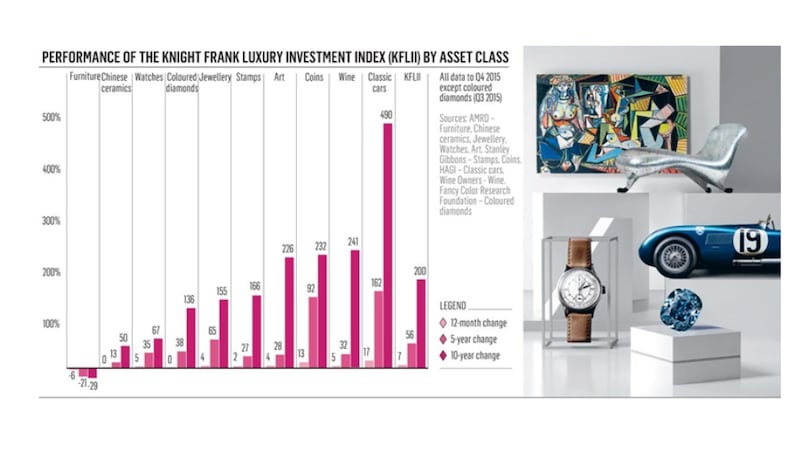It could be you. A new wealth report from London-based Knight Frank predicts that some 22,000 millionaires will be created in Ireland over the next 10 years. Not only that, but the rich are also going to get richer, with the report also revealing that more than 200 Irish people will enter the realm of the "ultra high net worth individual" (UHNWI): that's those with investable assets, usually property, of more than $30 million to you and me.
According to the Wealth Report 2016, there Ireland had 78,400 dollar millionaires (those with $1m-plus (€898,210) in investable assets) in 2015, the report shows, up from 66,400 in 2005. And a further 22,000 millionaires are set to be created by 2025, bringing Ireland’s population of millionaires past the 100,000 mark.
The rich are going to get richer too, with a further 770 multimillionaires ($10m-plus) set to be made by 2025, bringing the Irish number up to 3,330, while 235 UHNWI ($30m-plus) will be added to Ireland’s current population of 840 by 2025. With a growth rate of 28 per cent, Ireland’s rich are getting filthy rich at a faster rate than in Spain (14 per cent); Portugal (18 per cent) and France (15 per cent).

The trend reflects the overall recovery in property values and reduction in debt; something that has seen the net worth of the average Irish household rise to €133,225, the highest level since 2006, according to Central Bank figures from last month. Dublin is the main hub for Irish millionaires, with about one-third (26,600) living in the city, the report finds. At such a level, about one in every 50 people living in the capital is a dollar millionaire.
But it’s not all good news for Ireland’s richest; plummeting stock markets hit Irish UHNWI during the year, with their number falling by 1 per cent, on a par with the UK, and ahead of the 2 per cent decline reported in the US. Portugal, meanwhile, saw its number of UHNWI drop by 8 per cent, Spain by 10 per cent and Italy by 5 per cent. Overall, the report saw a 3 per cent decline in UHNWI.
Ireland experienced a 123 per cent increase in inward investment in the years 2005-2015, with some $895 billion. This represents the liabilities that are claims on local assets by foreign residents. While it’s difficult to be definitive on where this money went, Knight Frank says property forms “a significant part of the story”. More interesting perhaps, is the figure that shows that Irish investors actually invested more outside of Ireland during the period, with some $1.3 trillion invested outside between 2005-2015, up by 284 per cent from 2005.
Also on the property front, Dublin slumped in Knight Frank’s Prime Residential Index, which rates countries based on price growth. After a top 10 spot of seventh in last year’s survey, thanks to annual growth of 13.4 per cent, Dublin now ranks in 61st place, with an annual price increase of 0.6 per cent, sandwiched between Tokyo and Rome. Top of the index was Vancouver (+24.5 per cent); Sydney (+14.8 per cent) and Shanghai (+14.1 per cent). Bottom of the table were Lagos (-20 per cent); Buenos Aires (-8 per cent) and Megeve, a ski resort in France, (-6.7 per cent).
How they spend it The report also shines a light on the spending habits of the fabulously rich, although unfortunately Knight Frank doesn’t tell us what those working the 183 days Irish residency rules spend their money on.
Sales among the world’s most wealthy of “super-yachts”, which are longer than 24m, soared by 40 per cent last year, according to the survey, while coming ashore from a mooring in St Tropez to get sprayed with champagne in Nikki Beach is no longer exotic enough. Now the rich are foregoing the Mediterranean to cruise to the Antarctic or Asia.
The rich are also spending their money on football: not on going to matches or football tournaments, but buying football clubs. With huge new TV rights deals, Knight Frank says that clubs are beginning to look like a viable alternative asset class for those looking to diversify their portfolios, with Portugal's Primeira Liga offering good potential. Of course our own wealthy are no strangers to investing in football – Dermot Desmond is a majority shareholder in Celtic, for example – but the new investors might not even be football fans.
Passion investments
So-called “passion” investments, or high- value collectible items such as cars, watches and wine, are also on the up, with the value of the Knight Frank Luxury Investment Index (KFLII) up 7 per cent in 2015.
The best performing “passion” investment last year were classic cars, up by 17 per cent on the year, or by 490 per cent since 2005. The year saw all-time high results for Jaguar’s C-type works lightweight ($13.2m), Porsche ($10.1m) and McLaren ($13.75m), although the market is now softening the report says.
Wine also recovered during the year, up by 5 per cent, as investment-grade Bordeaux wines start to recover from the slump induced by the sharp drop in Chinese demand. Art was also in the black during the year, up by 4 per cent with notable sales including Picasso's Women of Algiers, which set an all-time auction high of $179 million. Watches were also up by 5 per cent in 2015, with a Patek Philippe Doctor's Chronograph watch making almost $5 million at auction.
















